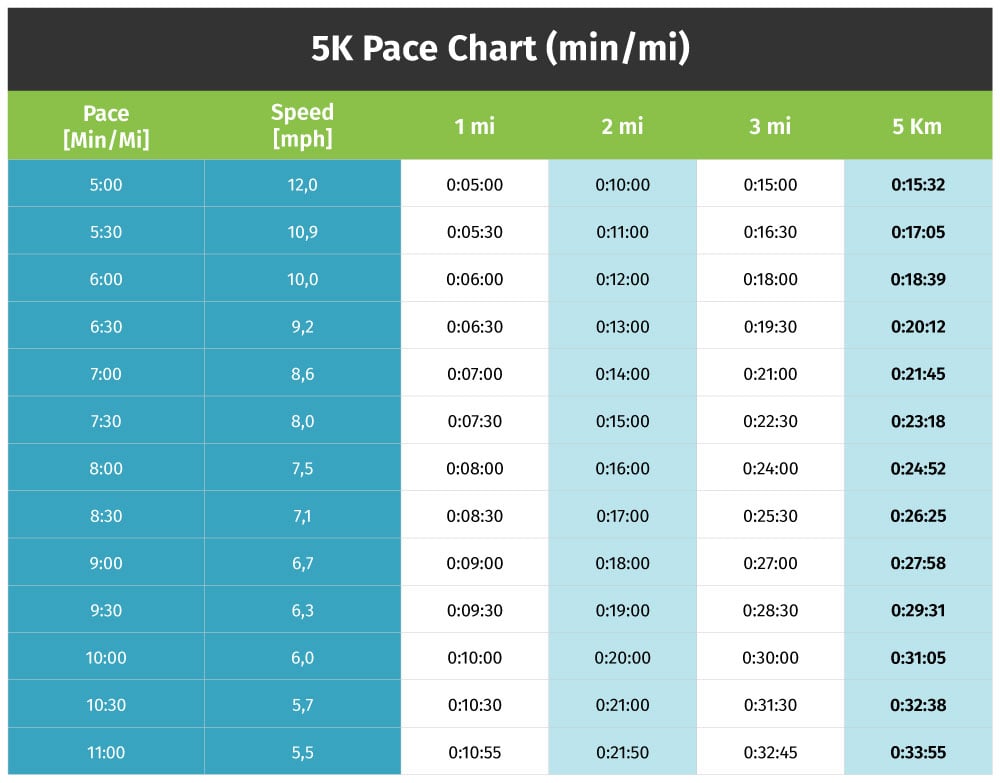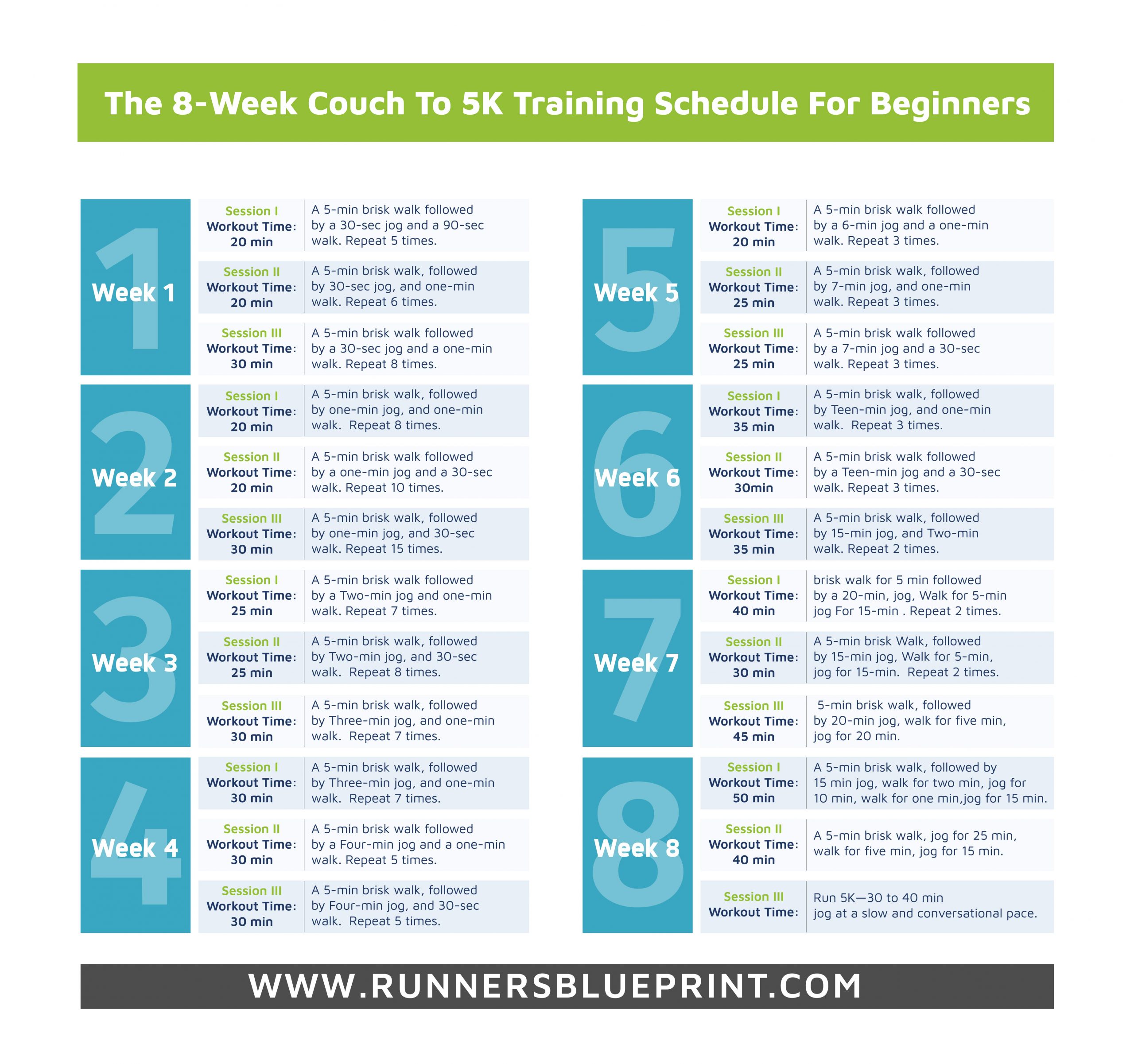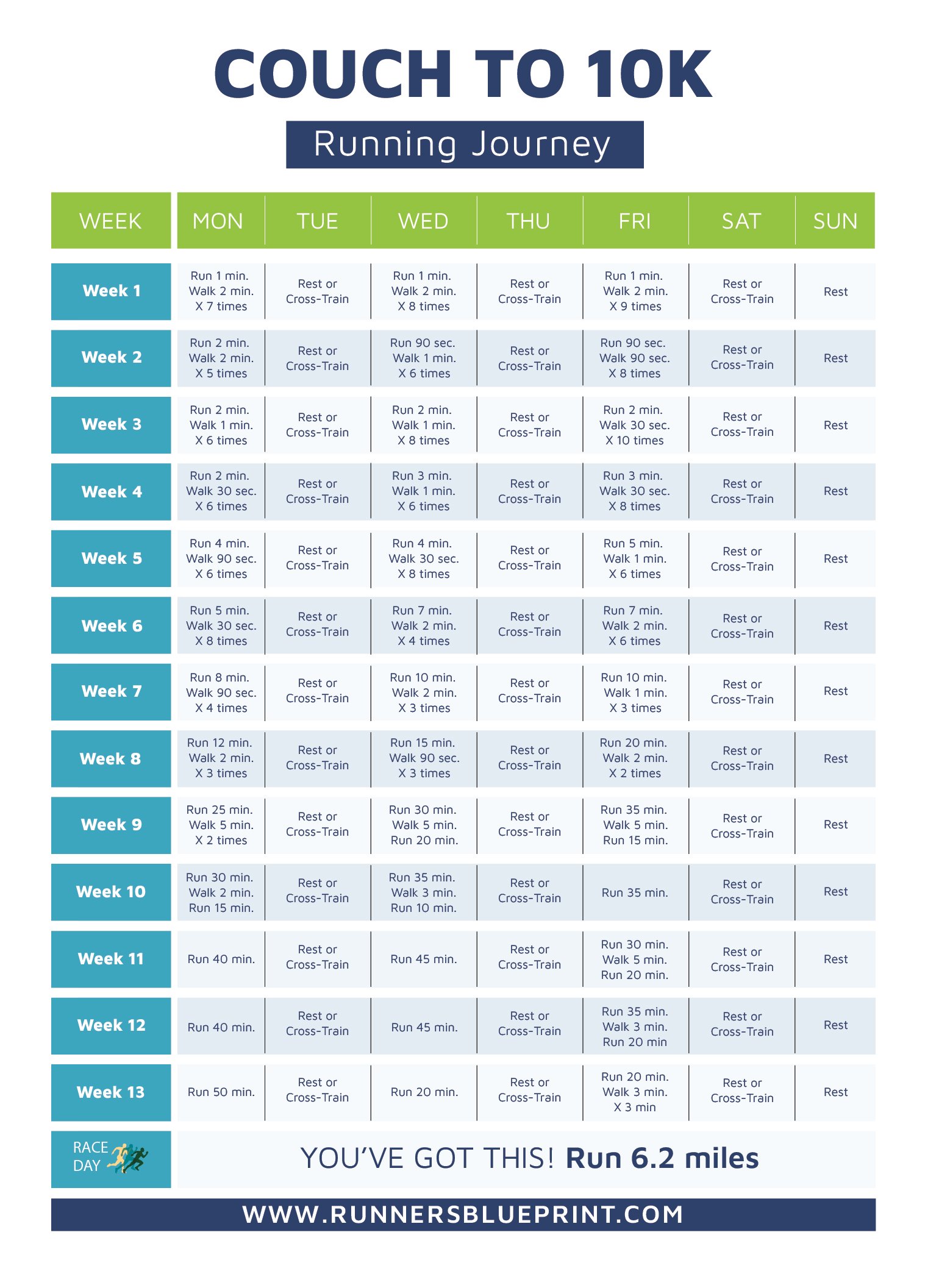Planning to do the 8 weeks Couch to 5K plan? Then you’ve come to the right place.
Running is a great way to get your body moving and heart racing, but taking up the sport for the first time can feel overwhelming, especially if you feel out of shape or unfit. In fact, as a beginner, it might seem unnerving to find your stride.
But you have to start somewhere, right? Progress first requires a step to be taken and all that. As far as I can tell, the best “gateway drug” to get you addicted to logging the miles is doing the famous Couch to 5K program.
There are various takes on this amazing program. In fact, do a quick search on the web, and you’ll definitely find 1000’s C25K plans to pick from. This makes choosing the right one for you easier said than done.
But it doesn’t have to be that way because today I got you covered.
In this comprehensive guide, I’m going to dive into everything you need to know about the Couch to 5k, including:
- What is the Couch to 5K program?
- Does it really work?
- How long does it take to finish the Couch to 5K program?
- Does The Couch To 5K plan actually work? (the secret sauce to the success)
- I’ve never Ran Before. Will I be able to improve?
- “Will I Lose Weight With the couch to 5K?”
- How Far is A 5K In Miles
- The Benefits Of The C25K Plan
- My C25K Schedule Explained
- “Can I do The Cough to 5K on A Treadmill?”
- How to train for a 5K
- The 8-Week Couch To 5K Plan For Beginners
- 5K Racing Tips For Beginners
- “How To Find a 5K near Me?”
- And so much more
Feeling ready?
Let’s lace up and dig in.
Note – In case the C25K plan seems too easy for you, check out my more challenging Couch to 10K plan.
What’s The Couch to 5K Program?
Also known as the C25K, or the sofa to 5K, the Couch to 5K plan is a popular running program that takes people from being non-runners to their first 5K event in a couple of months of training. In essence, the plan guides newbies toward running five kilometers—or 3.1 miles—on the road, track, trail, or a treadmill. (Learn more about how long is a 5K in miles here)
The C25K plan was initially designed by Josh Clark of Cool Running for his 50-something mother in the 1990s. Then in 1996, Josh posted the plan on a blog called Cool Running, which then spread around the internet like wildfire. Sadly the blog is no longer active (acquired by Active.com for an undisclosed amount).
The original plan involves three workouts per week with a recovery day in between and a different schedule for each of the nine weeks. This is achieved by making each session doable from the start by mixing jogging and walking to gently build a solid cardio base without overdoing it. From one week to the next, you’ll be slowly increasing intensity without you or your body even noticing.
Over the past 25 years, this original plan has been copied and tinkered with by hundreds of running blogs. There are eight and 16-week versions, and I’ve included my own C25K 9-week plan in this article. The initial Couch to 5K program takes around nine weeks to finish.
What’s more?
In 2016, the Couch to 5K plan had also been adapted into a free app known as C25K, turning into one of the most popular fitness apps out there.
That’s not the whole story.
The Sofa to 5K plan is so effective that it has been adopted by the National Health Service in the UK as a part of their plan to manage the rising rates of obesity and improve overall health.
How long does it take to Finish the Couch to 5K plan?
As I mentioned earlier, the initial C25K plan, as well as the NHS Couch to 5K, takes around nine weeks to finish.
But nothing is written in stone as it really depends on your starting point and fitness level. This means that it might take you 6, 8, or even 12 weeks to accomplish. My plan has eight weeks—but feel free to adjust it according to your own needs and preferences.
Different people, different strokes, and all that.
Overall, the shorter the plan, the more challenging it’ll be, so I’d urge you to pick a plan that matches your fitness level and running experience. If you feel like you have to repeat a week or two, then don’t lose sleep over it. Progress at your own pace. That’s what matters the most. The rest is just gravy.
Does The Couch To 5K plan actually work?
The simple answer is YES. Going from zero to 5K is just that.
The truth is, that millions of beginners have completed the C25K plan. In fact, the Couch to 5K plan might be the catalyst you need to make running a habit.
How come I’m so confident?
The plan works like a charm because it tells you EXACTLY what to do without needing to figure it out on your own—as long as you’re good at following instructions.
You’ll be training three times a week, for around 30 to 40 minutes each session. I recommend you train every other day if possible to give yourself enough recovery time.
The first week kicks off with around 6 to 8 one-minute jogs, broken up with 90 seconds of walking breaks between each.
Next, you tack on an extra 30 seconds to the jogging intervals on week two while adding full minutes of walking break between each jog. As a rule, these first few sessions should be practically painless, making the program ideal for anyone who isn’t used to running—or exercise in general.
Subsequently, the program builds up slowly as your endurance improves, meaning that the next target always feels relatively attainable. It’s the principle of gradual progress at work.
By the end of the c25k plan, you’re running for 30 minutes without huffing or puffing.
Following this training structure can allow you enough time to catch your breath, which is fantastic if you’re a beginner runner. It also makes the experience less scary by gradually easing you into running instead of getting you to log the miles right away.
I’ve Never Ran Before. Will I be able to improve?
The C25K plan is designed for beginners—like complete newbies with no running experience.
The truth is, as long as you do the sofa to 5K at your own pace, you’re on the right path. As a beginner, you’ll need time for your body and mind to adapt to running. Push harder than last time, and then you might develop injuries like Achilles tendonitis, runners knee, shin splints, or plantar fasciitis.
Just keep in mind that you might need to get the green light from your doctor first, especially if you have medical conditions, such as arthritis, back issues, or asthma.
Will I Lose Weight With The Couch to 5K Schedule?
I’m adding this point here since many people pick up running hoping to lose weight.
The simple answer would be yes.
Overall, running is a fantastic form of exercise to help you shed weight.
This is especially the case when backed up with a healthy diet, running is undoubtedly a great option for weight loss.
As you already know, weight loss is nothing but a number’s game –calories in VS. calories out. You lose weight when you burn more calories than you consume, and vice versa. Law of thermodynamics and all that.
No guarantees, though. In fact, exercise, let alone running, is often not enough to lose weight.
The truth is that forming a running habit doesn’t automatically make you lose weight. There are other variables that go into it, such as your nutrition, sleep, hormones, microbiome, stress levels, etc.
So if you run for 60 minutes, then get home, and stuff your mouth with junk food because you feel stressed at work and aren’t sleeping well, you’re not going to shed many pounds.
In other words, how much weight you’ll lose (or if any) while running completely depends on your body as well as the variables I mentioned above.
How Far is A 5K In Miles
So how far you’ll be actually running by the end of the C25K plan?
Of course, it’s, after all, in the name. I hate to dumb it down, but the “K” in 5K stands for a kilometer, so a 5K is EXACTLY 5 kilometers long.
If you live in one of the three strongholds of the imperial system– The United States of America, Liberia, and Myanmar—let me do the math for you:
One kilometer is the equivalent of 0.62 miles. Therefore, a 5K race is precisely 3.1 miles.
In other words, a 5K is the equivalent of running:
- The length of 45.5 football fields, including both end zones.
- 45 laps around a baseball diamond
- The length of an NBA basketball counts over 174 times.
The Average 5K Pace
All in all, the average 5K pace per mile is around 11-minute for men and 13-minute for women, resulting in finish times of roughly 35 and 42 minutes.
The keyword is a beginner. Veteran runners might be able to run a 7- or 8-minute mile pace, crossing the finish line within 20 to 25 minutes.
Check the chart below for more:
Get the full scope here.
The Benefits Of The Couch to 5K Schedule
A 5K race might not seem as much, but if you are a beginner, it can add a new level of challenge to your running lifestyle.
This race takes all comers—athletes from all fitness levels and training backgrounds.
It’s the perfect starting distance for beginner runners and a challenging test of speed and strength for those with years of training under their belts.
By crossing the finish line of a 5K race, you’ll be opening the door wide open for yourself to tackle new races and challenges. It’s the perfect stepping stone to more running adventures.
Additional resource – How to start running at 50
Can I do The Couch to 5K Program on A Treadmill?
Though nothing beats running outside, you can surely follow the C25K on a treadmill. In fact, it might be the right thing to do since it’s far less intimidating when you’re indoors or at the gym than outside braving the elements.
I’ve put together a full Couch to 5K treadmill guide here, explaining how to make the most out of indoor running as a beginner.
Where To Find Couch To 5K Groups Near me?
I’d recommend googling “couch to 5K groups near me” and checking Facebook or your local Council pages. You’ll find one as there are lots of C25K groups out there.
How To Train For your First 5K
To ensure you’re following the C25K plan the right way, make sure to incorporate the below training strategies to your training program.
Warm-up & Cool Down
To make the most out of your sessions, start each with a proper warm-up and then end it with the right cool-down.
Why is this important?
For starters, the right warm-up preps your body and mind for the hard task ahead.
It boosts blood flow to the working muscles, raises body temperatures, and increases heart rate, which results in improved performance and lower risk for injury.
So, what’s the ideal warm-up sequence?
Jog slowly for at least five minutes, then perform a set of dynamic stretches. Avoid static stretching before exercise, as research has shown that they may hinder performance and cause injury.
For a full guide to proper warm-ups, check my article here. Or check the following YouTube tutorial.
Once your session comes to a close, start cooling down.
A proper cool-down helps your body return to “normal” everyday function. It involves walking, or slow jogging, for five minutes while taking deep breaths and releasing tension.
Once your breathing rate is back to normal, perform a 10-minute full-body stretch, focusing on vital running muscles, such as the glutes, hamstrings, quadriceps, and calves.
Here are three of my favorite post-run stretching routines.
Listen to Your Body
As the weeks go by, pay attention to your body to avoid pushing yourself too hard.
I cannot emphasize this enough.
If you push yourself too hard while ignoring warning signs, you’ll, sooner than later, get yourself hurt. So don’t the “no pain, no gain” mindset dictate the pace and progress of your training.
Thinking that way will only cause more harm than good. Back off if you feel any weakness, sharp pain, or lightheadedness while running.
Do not push through nagging discomfort. After all, pain is your body’s signal that something is awry.
When it’s the case, stop doing whatever you’re doing.
Additional resource – How to promote a 5K
Be Realistic About Your C25K Plan
This should come as no surprise, but if you set too big of a goal and did too much too soon, you’ll be setting yourself up for a major failure.
And you don’t want that, do you?
Do not push yourself to do too much, too fast.
A competitive spirit will provide you with enough momentum to keep going strong, but it can also do more harm than good—if you don’t keep it realistic.
Remember always to train within your current physical activity.
Let your current fitness level dictate the pace and intensity of your training, not the other way around.
Additional Resource – The sub 20 5K training plan
Eat Well
Food is fuel. Accordingly, the main objective of eating should be to fuel you up, not to fill you up.
I keep saying this because it’s so true.
We are, after all, what we eat.
What you eat can either make you a faster runner or slow you down like nothing else, so pay attention to what you are putting into your mouth.
Check out the following post on how to maximize your nutrition.
- The beginners guide to runners diet.
- The Guide to Pre- and Post-eating For Runners
- The 9 Diet Mistakes Runners Make
- The 10 Vitamins & Minerals Every Runner Needs
Don’t Neglect Recovery
I often say that proper recovery is as vital as the training itself.
That might sound like a cliché thing, but it doesn’t make it less true.
So please, do not fall into the overtraining trap.
That’s when you log in too many miles and workouts without giving your body ample time to recover and bounce back from the training load.
Do this for an extended period, and you might end up with an injury and burnout.
Overtraining can spell disaster on race day and compromise the hard work and effort for the last few weeks of training.
Nonetheless, you can avoid all of the trouble if you are willing to listen to your body’s signal of pain and discomfort, then be willing to re-adjust accordingly.
Therefore, if you notice too many red flags, back off from your training program. Take an extra day off if you have to.
Just whatever you do, make a recovery a priority. Listen to your body both during and after your workouts.
Check my full guide on how to spot and deal with overtraining before it gets any worse than it is.
Build a Strong Foundation
As I have already stated, if you want a competitive racing experience—not just crossing the finish line—you have to build a strong foundation.
Besides the running, you should also be doing plenty of total-body strength workouts, at least a couple of times per week. Having enough total body strength will support and keep your body steady as you run mile after mile—especially once fatigue starts to set in.
Furthermore, building strength also improves training form and efficiency—all of which can help you run faster, farther, and with less fatigue.
Start with two to three sets of build strength and power in your muscles, joints, and tendons.
Additional resource – How To Run An 8-Minute Mile?
The Couch To 5K Plan In 8 Weeks
This couch to 5K schedule includes a combination of running, walking, and resting. This mix will help you get fit enough for a 5K distance without getting hurt.
Starting slow this way will help tame the risks of injury, fatigue, and stress while also improving your overall experience, endurance, and training enjoyment.
For example, during the first two weeks, you’ll jog for 15 to 30 seconds, then walk for one to two minutes, repeating for 20 to 30 minutes.
As training progresses, you’ll be jogging—and eventually running—more while taking shorter and fewer walk breaks.
Once you get to the last week, you’ll be able to run just over three miles without stopping.
That’s the ultimate goal of this beginner training program.
Pick any three days of the week and ensure you don’t run consecutive days. Feel free to cross-train or rest on your non-running days.
5K Racing Tips For Beginners
Training for a 5K has to have a purpose–and nothing beats the goal of finishing your first 5K race.
Here are a few tips that can help you cross the finish line.
Register For the 5K
To run a race, you’d need to sign up for one.
As a rule of thumb, choose a race roughly 6 to 12 weeks from now and register for it in advance.
By doing so, you’ll be better incentivized to train.
Not only that, favorite events typically sell out in advance, so you’d better reserve your spot months ahead.
And before signing up, consider the experience you want for your first 5K.
- Are you looking for a themed race?
- Do you want to raise money for charity?
- Or are you just doing it for fun?
How To Find a 5K near Me?
Let me good that for you. If you type “5K + Your village/town/city”, you’ll find plenty of 5Ks to join as countless events are organized every weekend across the country. You can also find local 5K local races listed on the Couch to 5K app.
I’ve also put together a complete guide on how to find 5K races in your area.
Deal with the Pre-race Jitters
It’s reasonable to feel anxious before a race, so try not to overthink it.
The adrenaline rush is a natural part of your body’s reaction to the competition.
That said, if you still have trouble with pre-race anxiety, here are a few tips that can help:
- Sleep well the few nights before the race.
- Control your thoughts using personal affirmations. Include them as a part of your training.
- Arrive at the race venue ahead of time so you aren’t rushed.
- Get familiar with the race course.
- Make a gratitude list in which you list all the things you’re grateful for.
- Make a list of compelling running mantras to help you overcome your anxiety and fears. Check mine here.
Get Ready the Day Before
This will help you reduce as much stress as possible on race morning.
To make it to the event venue without delay, remember to prepare the night before by organizing everything the night before the big day.
This is going to make sure that you got everything you need under control.
Lay out everything—from your bib number, shoes, clothing, pre-race snack, and everything else you might need so that you aren’t left frantically searching, half asleep, for your race essentials and items in the early morning.
Do this ahead of time, and you will have peace of mind.
Ensure an Awesome Racing Experience
To make the most of your racing experience, being an organized and systematic runner is the way to go.
Again, here are more tips to set you on the right path.
- Wear boring clothes. Do not try new clothes since they may cause skin abrasion and chafing. Instead, opt for the outfit that you wear during training.
- Dress for the weather. Your clothing is a performance tool, not a fashion statement.
- Race in the shoes you already use. Race day is not the time for trying a new pair because it may result in toe pain, foot blisters, and other lower leg issues. That will compromise your racing experience.
- Don’t be a John (or Jane) Doe. Instead, identify yourself by putting your personal information, bib number, and e-mail address on your race bib.
- Reach the venue at least one hour before the race. This gives you enough time to relax and get acquainted with what’s happening around you.
Apply your Working Strategy
As I have already stated, do not try or do anything new or different on race day—whether it’s your diet, running shoes, running form, pre-race warm-up, or whatever.
On the big day, all you have to do to execute the strategy you’ve been working hard and diligently for the last few months.
During the Race
Do the warm-up you used to do during your training days.
No need to reinvent the wheel. For a good dynamic warm-up, feel free to steal my routine here.
I hate to sound like a broken record. But WHATEVER you do, do not stretch a cold muscle.
Doing so will only hinder your performance and might lead to a muscle tear.
Don’t Be a Rabbit
If it’s hard for you to keep up the pace, slow down, or even take a walking break to catch up on your breath and recover.
But whatever your plan, start slowly, and build your speed gradually.
And please, DO NOT wait until you are completely drained before taking a one to two-minute walking break.
Remember.
This should be challenging. But if it’s too much, you might not even be able to complete the race.
Break it Down
If the 3.1-mile distance is too much for you, then one trick you do to make it seem easier is to break the 5K distance into three chunks (or mini races, if that helps).
Then, keep your focus on reaching that first mile.
As you approach the few hundred last meters, finish strong.
Pick up the pace and give it everything you got.
For the last quarter mile or so, go for the gold and run to the finish line as fast as you can.
Leave nothing in the tank.
Want to take things to the next level? Try running a 5K in 30 minutes. Or my sub 20 5K training plan.You can also go for a sub 60 10K
Sofa to 5K – The Conclusion
There you have it.
The above Couch to 5K plan guidelines are all you need to run your first 5k in two months or less.
All you need to do is show up, do the work, and never deviate.
The rest is just detail.
Please feel free to leave your comments and questions in the section below.
In the meantime, thank you for reading my post.
Keep Running Strong.
David D.





















